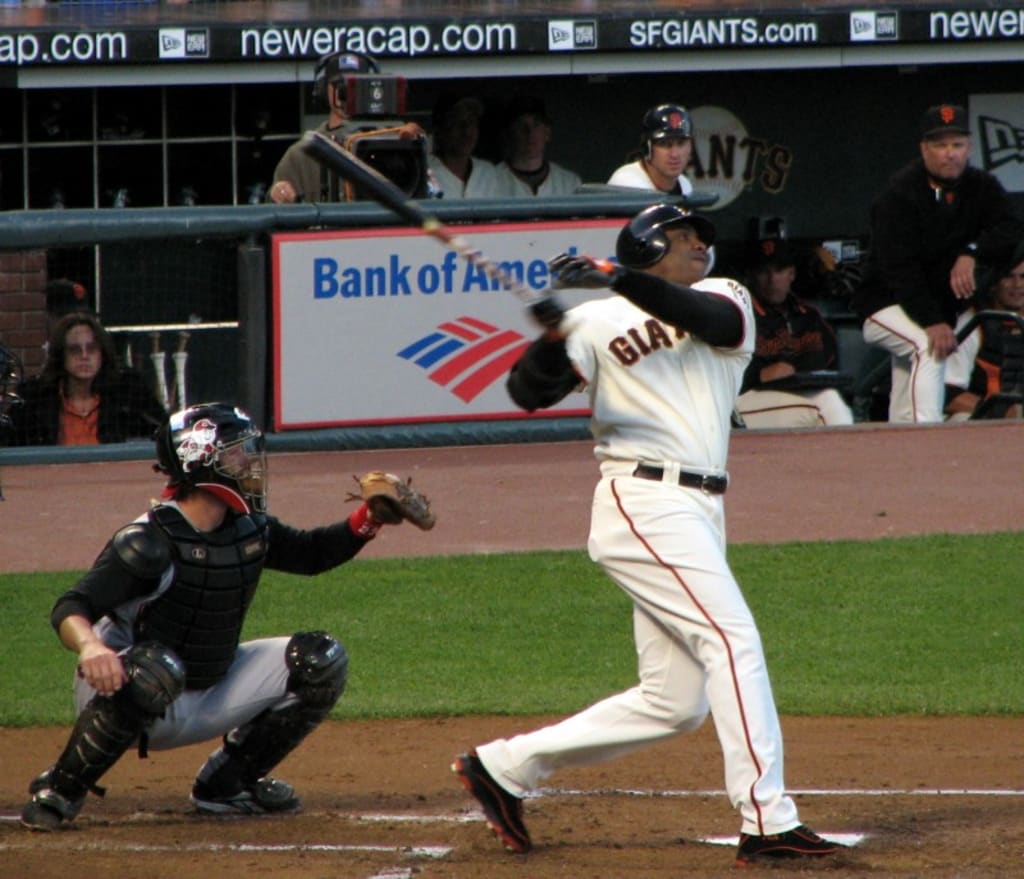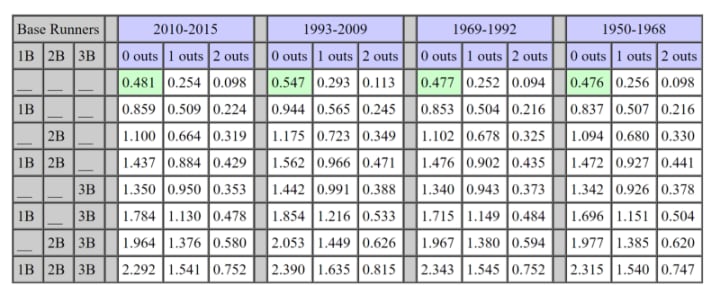Giving Players the Bonds Treatment
The Bonds Treatment, designated for only the greats, would make sense for various players you wouldn’t believe

There is no higher compliment that can be given to a ballplayer than to be given “The Bonds Treatment” — being intentionally walked with the bases empty, or even better, with the bases loaded. It’s called “The Bonds Treatment” because Bonds recorded an astounding 41 IBBs with the bases empty, and is one of only two players to ever record a bases loaded intentional walk. In other words, 28% of IBBs ever issued with the bases empty were given to Bonds — and 50% of IBBs with the bases loaded. Bonds was great, no denying that — but is there anyone out there today who is worthy of such treatment?
We can find out using a Run Expectancy matrix. An RE matrix is based on historical data, and it can tell you how many runs, on average, a team could expect to score in a given situation. A sample RE matrix, from Tom Tango’s site tangotiger.net, is shown below.

tangotiger.net
The chart works as follows — given a base situation (runners on the corners, bases empty, etc.) move down to the corresponding row, then move to the corresponding column and year to find out how many runs a team could expect to score from that situation. In 2015, with a runner on 3rd and 1 out, teams could expect to score .950 runs on average (or, RE is .950).If the batter at the plate struck out, the new RE would be .353.
We can take this a step further. Sean Dolinar created a fantastic tool that allows us to (roughly) examine RE in terms of a batter’s skill. Having Mike Trout at the plate vastly improves your odds of scoring more than having Alciedes Escobar, and this tool takes this into account. We can use this tool to look at who deserves the Bonds treatment in 2017 (or, to see if anyone deserves the Bonds treatment).
First, we can look at a given player and their RE scores for having the bases empty or full. In this instance, we’ll use Michael Conforto, who batted lead off for the Mets against the Texas Rangers on August 9th. Conforto’s wOBA entering the game was .404, and the run environment for the league is 4.65 runs per game, so Conforto’s relevant run expectancy matrix looks like this:

Batting behind him was Jose Reyes, who entering the game, had a wOBA of .283. Let’s assume that Conforto receives the Bonds Treatment, and is IBB’d in a given PA with bases empty or loaded. What would the run expectancy look like with Reyes up? In other words, what is Reyes’ run expectancy with a runner on first, or with the bases loaded after a run has been IBB’d in?
To do this, we can look at Reyes’ RE with a runner on first and with the bases loaded. Reyes’ RE with a man at 1B is indicative of what the RE would be like if Conforto had been given an intentional free pass. For a bases loaded walk, we look at Reyes’ RE with the bases loaded, and then add a run onto it (to account for Conforto walking in a run).

Then, we can compare the corresponding cells of the matrices to see if the Texas Rangers would benefit any from walking Conforto. If RE with Conforto up and the bases empty is higher than RE with a runner on first and Reyes up, or RE with the bases loaded and Conforto up is higher than RE with Reyes up and a run already scored, then we can conclude that it makes sense to give Conforto that free pass.
In this instance, we can see that if the Rangers were to face Conforto with the bases empty and two out, it would make more sense for them to IBB Conforto and pitch to Reyes than it would for them to pitch to Conforto, because RE with Conforto up (.172) is higher than RE with Reyes up and Conforto on (.145). As a result, Conforto is a candidate for the Bonds treatment in this lineup configuration, if the right situation arises.
Who else could be subjected to the Bonds treatment? It would take me a few months of work to run through every single individual lineup for every team to figure out who should have been pitched to and who should have gotten a free pass, so to simplify things, I looked at hitters with 400+ PA, looked at when they most frequently batted, who batted behind them most frequently, and whether or not they should have received the Bonds treatment based on who was on deck. While no lineup remains constant throughout the season, looking at these figures gave me a good idea of who regularly batted behind whom.
Three candidates emerged to be IBB’d with the bases empty every time regardless of outs— Yasiel Puig, Jordy Mercer, and Orlando Arcia. These players usually bat in the 8th slot on NL teams, and right behind them is the pitchers’ slot -considering how historically weak pitchers are with the bat, it makes sense that RE tells us to walk them with the bases empty every single time.
The same could be said of almost anyone batting ahead of a pitcher — according to the model, given an average-hitting pitcher, any hitter with a wOBA over .243 should be IBB’d with the pitcher on deck (only one qualified hitter — Alciedes Escobar — has a lower wOBA than .243). The three names above stuck out in the analysis because they were the only players with 400+ PA that had spent most of their PAs batting 8th.
So, an odd takeaway of this exercise is that in the NL, unless a pinch hitter is looming on deck, the eighth hitter should almost always be intentionally walked with the bases empty, because it lowers the run expectancy. Weird!
The model also identified two hitters who deserved similar treatment to Michael Conforto in the above example (IBB with 2 out and no one on)— Buster Posey and Chase Headley.
Posey has batted with almost alarming regularity ahead of Brandon Crawford, who is running an abysmal .273 wOBA on the season. Headley is a little more curious: Headley is usually a weak hitter, but earlier in the season, Headley batted ahead of Austin Romine frequently, who was even worse than Crawford.
Headley technically isn’t that much of a candidate for the Bonds Treatment since Romine hasn’t batted behind him since June 30th, but Crawford has backed up Posey as recently as August 3rd — if he’s batted behind Posey again, the situation could very well arise where it becomes beneficial for teams to simply IBB Posey with 2 out and bases empty.
But ultimately, no one, aside from NL hitters in the 8th slot, emerges as a candidate to be IBB’d every time with the bases empty. And no one, regardless of the situation, deserves the dreaded bases loaded intentional walk. Which raises the question — was it appropriate to give the man himself, Barry Bonds, the Bonds Treatment?
Bonds received an incredible 19 bases empty IBBs in 2004 (more than doubling the record he set in 2002), so we’ll use 2004 Bonds and his .537 wOBA as the center of our analysis.
In 2004, Bonds batted almost exclusively 4th, and the two men who shared the bulk of playing time batting 5th behind him (Edgardo Alfonzo and Pedro Feliz) had almost identical wOBAs that season (.333 and .334, respectively) — so we’ll assume that the hitter behind Bonds in 2004 posted a wOBA of .333. This yields RE matrices that look like this:

Bonds proves himself worthy not only of a bases empty IBB with 2 out, but he just barely misses with a bases loaded IBB. While no one ended up giving Bonds a bases loaded IBB in 2004, they did give him one in 1998:
For perspective, Bonds was running a .434 wOBA in 1998, and Brent Mayne (who was on deck) was running a .324 wOBA — so this actually wasn’t a move that moved RE or win probability in the right direction.

The final spike in WPA is Bond’s IBB — it gave the Giants a better chance of winning. Ultimately, it was a bad idea that didn’t backfire in the Diamondback’s faces.
And of course, I would be remiss in not mentioning the other player to have ever received a bases loaded IBB — Josh Hamilton.
With apologies to Hamilton, he wasn’t the right guy to IBB with the bases loaded either — Hamilton ran a .384 wOBA in 2008, and Marlon Byrd, who was on deck, had a .369 wOBA, which means that an IBB in this instance was a really awful move. An awful move that, like Bond’s IBB, was rewarded by Byrd striking out in the next AB.
Have there been other players deserving of bases loaded IBBs? It’s possible, but the most likely candidates — Ted Williams and Babe Ruth — usually had good enough protection in the lineup. Of course, there are few hitters that could have protected Bonds from himself — hence why it’s almost a good idea to IBB him with the bases loaded.
About the Creator
John Edwards
Staff Writer for The Unbalanced, Contributor at Sporting News.






Comments
There are no comments for this story
Be the first to respond and start the conversation.